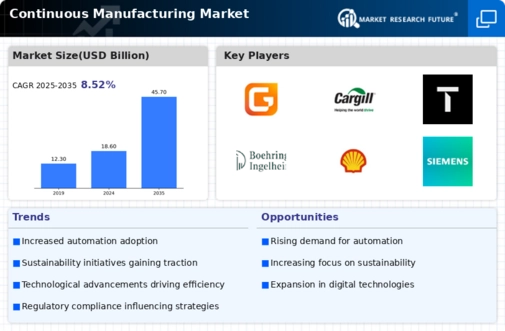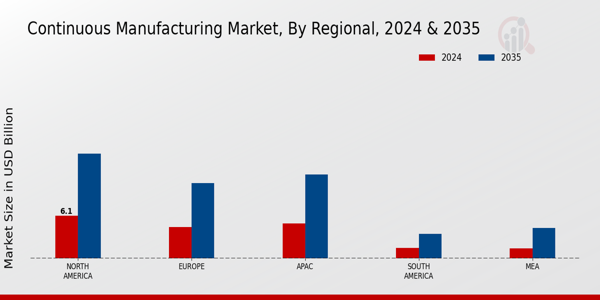Technological Innovations
Technological innovations play a pivotal role in shaping the Continuous Manufacturing Market. The integration of advanced technologies such as artificial intelligence, machine learning, and the Internet of Things is revolutionizing manufacturing processes. These technologies enable real-time monitoring and predictive maintenance, which can significantly enhance operational efficiency. For instance, companies that have adopted these innovations report a 20% increase in production efficiency. Furthermore, automation in continuous manufacturing reduces human error and increases safety, making it an attractive option for manufacturers. As these technologies continue to evolve, they are expected to drive further growth in the Continuous Manufacturing Market.
Rising Focus on Sustainability
Sustainability has emerged as a critical driver in the Continuous Manufacturing Market. With increasing awareness of environmental issues, manufacturers are adopting continuous processes that minimize waste and energy consumption. This shift is not merely a trend but a necessity, as regulatory bodies impose stricter environmental standards. Data indicates that companies implementing sustainable practices in their manufacturing processes can achieve up to a 25% reduction in energy usage. This focus on sustainability not only meets regulatory requirements but also appeals to environmentally conscious consumers, thereby enhancing brand reputation. As sustainability becomes a core value, the Continuous Manufacturing Market is likely to see accelerated growth.
Increased Demand for Efficiency
The Continuous Manufacturing Market is experiencing a surge in demand for efficiency across various sectors. Companies are increasingly seeking methods to streamline production processes, reduce waste, and enhance product quality. This trend is driven by the need to lower operational costs while maintaining high standards. According to recent data, industries utilizing continuous manufacturing techniques have reported up to a 30% reduction in production time. This efficiency not only improves profitability but also allows for quicker response times to market changes. As competition intensifies, the adoption of continuous manufacturing processes is likely to become a standard practice, further propelling the growth of the Continuous Manufacturing Market.
Global Supply Chain Optimization
The optimization of The Continuous Manufacturing Industry. As businesses expand their operations internationally, the need for efficient supply chain management becomes paramount. Continuous manufacturing processes facilitate better inventory management and reduce lead times, which are essential for meeting global demand. Recent studies suggest that companies employing continuous manufacturing techniques can reduce supply chain costs by up to 15%. This optimization not only enhances competitiveness but also allows for greater flexibility in responding to market fluctuations. As supply chain dynamics evolve, the Continuous Manufacturing Market is expected to benefit significantly from these trends.
Regulatory Support and Compliance
Regulatory support is a significant driver for the Continuous Manufacturing Market. Governments worldwide are increasingly recognizing the benefits of continuous manufacturing processes, leading to favorable policies and incentives. These regulations often aim to enhance product safety, quality, and environmental sustainability. For example, certain regions have introduced tax incentives for companies that adopt continuous manufacturing technologies. This regulatory support not only encourages investment in advanced manufacturing techniques but also fosters innovation within the industry. As compliance with these regulations becomes essential, the Continuous Manufacturing Market is poised for substantial growth as companies seek to align with governmental standards.



















Leave a Comment